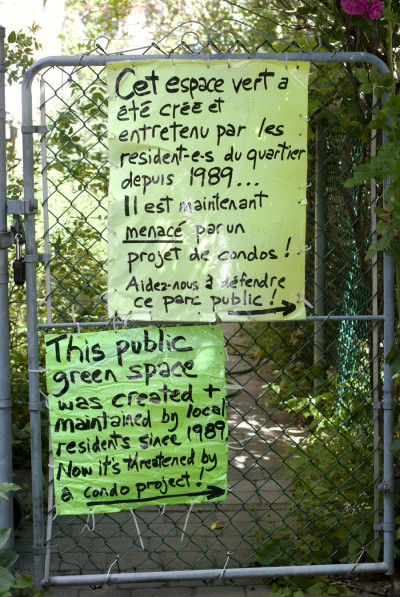On Sept. 3, residents of the Plateau-Mont-Royal borough expressed their concerns for preserving of green space in the neighbourhood at a conference and question and answer session with the borough’s mayor, Luc Ferrandez. Debate on the topic centered around the preservation of Parc Oxygène, a privately -owned alleyway that has been serving as a park for over 20 years.
Parc Oxygène was originally an alleyway used by motorists as a shortcut through the residential neighborhood bordered by Prince Arthur street and Pine Avenue. Although members of the neighborhood protested that this use of the alleyway was dangerous, the city did not act in response to these claims. In 1989, the alleyway was converted into a park, which residents of the community currently take care of.
In the past few years, a condominium proposal as well as multiple construction ideas—including parking lots and small residential housing—have been suggested to replace the park area. As a long-time resident of the area surrounding the park, Norman Nawrocki has been very active in the fight to preserve one of the area’s only remaining green spaces. He explained that residents are attempting to save the park from development by requesting that the city purchase the land and declare it an official park.
“It is a community-created green space; [it] has been this [way] for 23 years, and needs to be preserved as such,” he said. “The greater interests and rights of the community take precedence over the rights and interests of a private developer.”
Some community members, however, were skeptical of the claim that private developers threaten the park. One community member, who asked only to be identified as Clement, said he believes the park will not be dramatically developed due to space constraints.
“I would be very surprised if a condo went up in that area, whether it is or isn’t an official city park—at most maybe a parking space, or small housing [developments], but no condo,” he said. “The space is too tiny.”
Ferrandez argued that the costs of purchasing the piece of land is not worth the investment.
“[There is a] six million dollar price tag on such a small urban space,” Ferrandez said. “[The space is] so small that [it] might not be sufficient to guarantee legal paperwork with which to present enough evidence for saving the park.”
He also stated that, as mayor, he could not take action to save Parc Oxygène.
“The mayor simply cannot get involved in a legal battle between private developers and members of the community,” he said. “It isn’t my place, and that’s all I have to say on the matter. We cannot legally sustain a project like Parc Oxygène.”
Nawrocki expressed disagreement, and argued that the benefits of the green space for the borough are substantial enough that the mayor should step in to save the park.
“It provides a public space for people— including McGill students— to hang out in and socialize, enjoying the trees, flowers, birds, bees, peace, and fresh air,” he said. “It has a history and is now an important part of the local community.”
Kira Page, a member of the Quebec Public Interest Research Group McGill (QPIRG), explained the importance of the issue to McGill students, many of whom reside in the area near the park. She said QPIRG has worked together with Nawrocki for some time to raise awareness of the issue.
“Over the last several years, McGill students have been attending events to help save the park, helping spread the word about Parc Oxygène, […] all the while learning about the history of the neighbourhood we study in,” Page said.








also already scooped by the daily – I am sorry but you seem to have no new leads – why should I read your paper